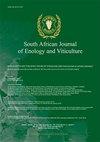Susceptibility of Grapevine Sucker and Green Shoot Wounds to Trunk Disease Pathogens
IF 1.1
4区 农林科学
Q4 FOOD SCIENCE & TECHNOLOGY
引用次数: 0
Abstract
Grapevine trunk disease fungi infect vines through openings, primarily pruning wounds. The main objective of this study was to understand the role of sucker wounds and wounds made by the removal of green shoots from the stems of potted grapevines as potential points of infection for grapevine trunk disease pathogens. Six wine and four table grape vineyards of different ages were sampled in different production areas in the Western Cape grape region of South Africa. Isolations were made from 161 sucker wounds, and fungal pathogens were identified using morphology and DNA sequence analysis of the internal transcribed spacers (ITS1 and ITS2) and the 5.8S ribosomal RNA gene, the translation elongation factor 1alpha or the partial β-tubulin gene. The results show that 62% of the sucker wounds were infected by trunk disease pathogens, including Diaporthe ampelina, Diplodia seriata, Phaeomoniella chlamydospora, Phaeoacremonium minimum, Eutypella microtheca, Cryptovalsa ampelina and Neofusicoccum australe. Diaporthe ampelina was the most common, followed by D. seriata and P. chlamydospora, in both the wine and table grape sucker wounds. Under glasshouse conditions, wounds made by the removal of young green shoots on one-year-old potted grapevine plants were inoculated with spore suspensions of D. ampelina, E. lata, N. parvum, P. minimum and P. chlamydospora. After four months, all the inoculated pathogens could be re-isolated. This study shows that grapevine sucker and green shoot wounds are susceptible to different grapevine trunk disease pathogens and may therefore play a role in the epidemiology of trunk diseases.葡萄吸盘和绿芽伤对树干病病原菌的敏感性
葡萄树干病真菌通过开口感染葡萄藤,主要是修剪伤口。本研究的主要目的是了解吸盘伤口和从盆栽葡萄茎上取下绿芽所造成的伤口作为葡萄树干病病原体的潜在感染点的作用。在南非西开普省葡萄产区的不同产区,对六个不同年份的葡萄酒和四个葡萄园进行了取样。从161个吸盘伤口中分离出真菌病原体,并通过对内部转录间隔区(ITS1和ITS2)和5.8S核糖体RNA基因、翻译延伸因子1α或部分β-微管蛋白基因的形态学和DNA序列分析鉴定真菌病原体。结果表明,62%的吸盘伤口感染了主干病病原体,包括双孢Diaporthe ampelina、Diplodia seriata、厚壁藻Phaeomoniella chlamydospora、Phaeoacremonium minimum、Eutypella microtheca、Cryptovalsa ampelina和Neofusicoccum australe。在葡萄酒和餐桌葡萄的吸盘伤口中,ampelina最常见,其次是D.seriata和P.chlamydospora。在温室条件下,用D.ampelina、E.lata、N.parvum、P.minimum和P.chlamydospora的孢子悬浮液接种一年生盆栽葡萄植株上去除幼芽所造成的伤口。四个月后,所有接种的病原体都可以重新分离。这项研究表明,葡萄吸盘和青芽伤口易受不同葡萄树干疾病病原体的影响,因此可能在树干疾病的流行病学中发挥作用。
本文章由计算机程序翻译,如有差异,请以英文原文为准。
求助全文
约1分钟内获得全文
求助全文
来源期刊
CiteScore
2.50
自引率
7.70%
发文量
1
审稿时长
>36 weeks
期刊介绍:
The South African Journal of Enology and Viticulture (SAJEV) publishes full-length original Research Papers, Research Notes and Review Papers on all subjects related to enology and viticulture. The SAJEV does not accept articles published in, or submitted to, other journals.

 求助内容:
求助内容: 应助结果提醒方式:
应助结果提醒方式:


